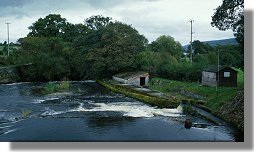|
The Editors
Catherine
Duigan and Dudley Williams give
examples of how the rivers of
Wales have contributed to our
understanding of the natural world.
Dr.
CATHERINE DUIGAN is currently
the Head of the Marine and Freshwater
Ecosystems Group at the Countryside Council
for Wales (CCW), the government's
advisory body on all aspects of
nature conservation in Wales.
Born in Ireland, her career allowed
her to work extensively on the
Celtic fringe - Ireland, Scotland
and Wales. She is fascinated by
the historic relationships between
rivers and their landscapes, biota
and people.
You can also follow Catherine on Twitter.com/kate_llyn
"In
October, 2000, I was exploring
the River Dee and its tributaries
as this river was being put forward
as an internationally important
conservation site in response
to a European Directive. As the
salmon population was identified
as a key component its ecosystem,
a local CCW colleague suggested
that we should visit the "old
fish traps" on the River
Alwen. As we stood on the narrow
footbridge over the river, we
worked out how some of the water
was diverted into an artificially
constructed side channel and through
a series of compartments. A small
brick building with an angled
flat roof still occupied the site.
 Shortly
afterwards I picked up a copy
of The Salmon written in
1959 by Jack Jones, at the time
a lecturer at the University of
Liverpool. It was only then that
I appreciated the scientific importance
of the site on the Alwen. Huddled
against the cold and damp, and
struggling with floods and intermittent
lighting, Jack Jones spent 3,000
hours observing and sometimes
filming over 90 salmon spawnings
in a glass walled observation
tank. His dedication allowed him
to produce the first complete
and detailed scientific account
of spawning behaviour in salmon.
He also used salmon eggs to entice
a curious dipper into the observation
tank and wrote of the wonderful
sight of its submerged body shining
like silver because of the air
retained by its feathers." Shortly
afterwards I picked up a copy
of The Salmon written in
1959 by Jack Jones, at the time
a lecturer at the University of
Liverpool. It was only then that
I appreciated the scientific importance
of the site on the Alwen. Huddled
against the cold and damp, and
struggling with floods and intermittent
lighting, Jack Jones spent 3,000
hours observing and sometimes
filming over 90 salmon spawnings
in a glass walled observation
tank. His dedication allowed him
to produce the first complete
and detailed scientific account
of spawning behaviour in salmon.
He also used salmon eggs to entice
a curious dipper into the observation
tank and wrote of the wonderful
sight of its submerged body shining
like silver because of the air
retained by its feathers."
DUDLEY
WILLIAMS is Professor of Environmental
Science at the University of Toronto,
Canada. Born in Laugharne (Dylan
Thomas territory), he has returned
to Wales many times to work on
Welsh rivers, and is an Honorary
Professor at the University of
Wales, Bangor. His area of expertise
centres around the structure and
function of the invertebrate communities
that are the facilitators and
indicators of running water health.
 "An
early experience was at the Afon
Hirnant in Gwynedd, where in the
1960s my postgraduate supervisor
Noel Hynes had done the seminal
study that was to define the discipline
of running water science. It was
then, and is still, an inspirational
stream and watershed. "An
early experience was at the Afon
Hirnant in Gwynedd, where in the
1960s my postgraduate supervisor
Noel Hynes had done the seminal
study that was to define the discipline
of running water science. It was
then, and is still, an inspirational
stream and watershed.
My
'baptism' at the Hirnant led to
work on another Gwynedd mountain
stream: Yr Ogof, near Bangor.
Here I tried to solve a longstanding
running water paradox (why don't
stream headwaters gradually become
depleted of their faunas as individuals
are carried downstream by the
current?), with some success -
although, as usual, nature demonstrated
that there is more than one solution
to a problem.
Having
begun my academic studies as a
marine zoologist, I next turned
to the estuary of the Aber River,
again in Gwynedd, to try to find
out what use might be made of
the invertebrates drifting down
from upstream. The results were
unexpected and showed that they
were consumed by tiny waiting
flounder larvae, which increased
their weight by more than 100
times on this diet before returning
to the sea."
|